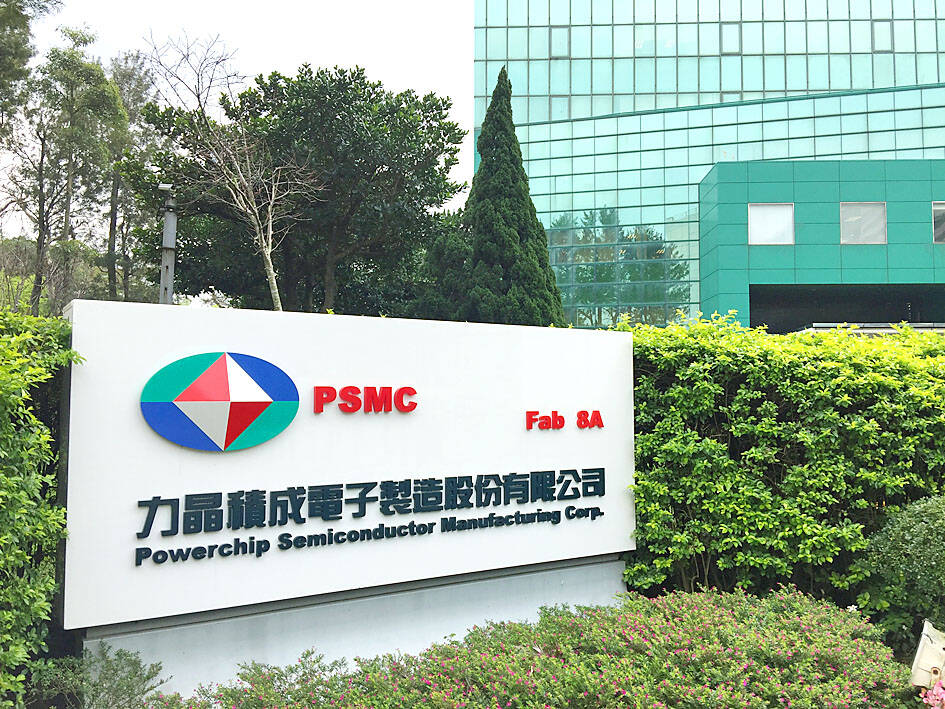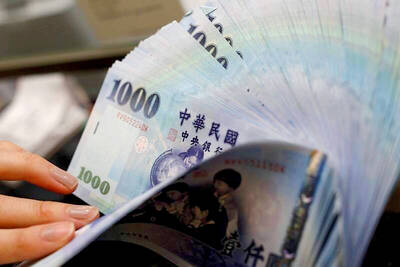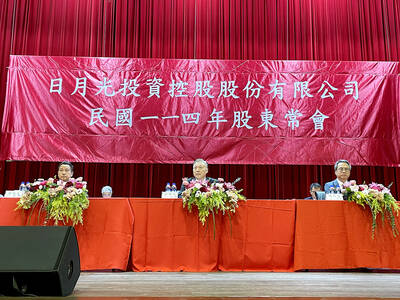Powerchip Semiconductor Manufacturing Corp (力積電) yesterday reduced capital spending for this year by about 43 percent to US$850 million, due to sluggish demand for display driver ICs and DRAM chips.
The company primarily makes display driver ICs and power management ICs.
Powerchip had planned to invest US$1.5 billion in new facilities and manufacturing equipment to expand 12-inch wafer capacity in Miaoli County’s Tongluo Science Park (銅鑼科學園區).

Photo: Grace Hung, Taipei Times
However, sluggish demand for CMOS image sensors and driver ICs used in handset and TV displays have caused a significant increase in customers’ inventories, it said.
Inventories at DRAM customers have also been piling up, due to sluggish demand, it added.
The DRAM, display driver IC and image sensor businesses contributed about 62 percent to the company’s revenue last quarter.
“Customer demand has reversed after our revenue peaked in the second quarter,” Powerchip president Brian Shieh (謝再居) told an online conference. “We expect customers to request production cuts to adjust their inventories in the third and fourth quarters.”
As some customers, mainly driver IC companies, have defaulted on long-term supply agreements, Powerchip has agreed to extend some contracts by six months to one year to help customers avoid payment penalties, Shieh said.
Aside from sagging demand, serious delays in construction at the science park, limited accessibility to key manufacturing equipment and labor shortages have factored in the decision to reduce capital spending, he said.
Powerchip expects the new fab to start test runs in the third or fourth quarter of next year, rather than at the beginning of next year, Shieh said.
The chipmaker expects revenue decline this quarter to slow down from last quarter’s 12 percent drop, he said.
Net profit last quarter dropped 13.5 percent to NT$6.07 billion (US$190.3 million), compared with NT$7.02 billion in the second quarter.
On an annual basis, net profit surged 37.64 percent from NT$4.41 billion.
In the first three quarters of this year, net profit soared about 99 percent to NT$19.72 billion from NT$9.89 billion a year earlier, with earnings per share expanding from NT$3.07 to NT$5.4.
The US’ new curbs on chip exports to China would benefit the company, as it would lead to more orders from customers, Powerchip said.

Merida Industry Co (美利達) has seen signs of recovery in the US and European markets this year, as customers are gradually depleting their inventories, the bicycle maker told shareholders yesterday. Given robust growth in new orders at its Taiwanese factory, coupled with its subsidiaries’ improving performance, Merida said it remains confident about the bicycle market’s prospects and expects steady growth in its core business this year. CAUTION ON CHINA However, the company must handle the Chinese market with great caution, as sales of road bikes there have declined significantly, affecting its revenue and profitability, Merida said in a statement, adding that it would

RISING: Strong exports, and life insurance companies’ efforts to manage currency risks indicates the NT dollar would eventually pass the 29 level, an expert said The New Taiwan dollar yesterday rallied to its strongest in three years amid inflows to the nation’s stock market and broad-based weakness in the US dollar. Exporter sales of the US currency and a repatriation of funds from local asset managers also played a role, said two traders, who asked not to be identified as they were not authorized to speak publicly. State-owned banks were seen buying the greenback yesterday, but only at a moderate scale, the traders said. The local currency gained 0.77 percent, outperforming almost all of its Asian peers, to close at NT$29.165 per US dollar in Taipei trading yesterday. The

RECORD LOW: Global firms’ increased inventories, tariff disputes not yet impacting Taiwan and new graduates not yet entering the market contributed to the decrease Taiwan’s unemployment rate last month dropped to 3.3 percent, the lowest for the month in 25 years, as strong exports and resilient domestic demand boosted hiring across various sectors, the Directorate-General of Budget, Accounting and Statistics (DGBAS) said yesterday. After seasonal adjustments, the jobless rate eased to 3.34 percent, the best performance in 24 years, suggesting a stable labor market, although a mild increase is expected with the graduation season from this month through August, the statistics agency said. “Potential shocks from tariff disputes between the US and China have yet to affect Taiwan’s job market,” Census Department Deputy Director Tan Wen-ling

UNCERTAINTIES: The world’s biggest chip packager and tester is closely monitoring the US’ tariff policy before making any capacity adjustments, a company official said ASE Technology Holding Inc (日月光投控), the world’s biggest chip packager and tester, yesterday said it is cautiously evaluating new advanced packaging capacity expansion in the US in response to customers’ requests amid uncertainties about the US’ tariff policy. Compared with its semiconductor peers, ASE has been relatively prudent about building new capacity in the US. However, the company is adjusting its global manufacturing footprint expansion after US President Donald Trump announced “reciprocal” tariffs in April, and new import duties targeting semiconductors and other items that are vital to national security. ASE subsidiary Siliconware Precision Industries Co (SPIL, 矽品精密) is participating in Nvidia